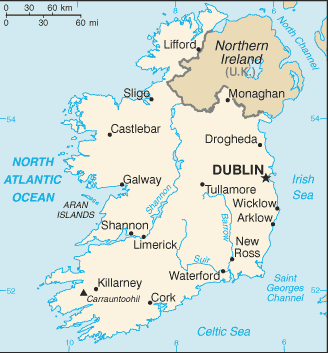Europe > Ireland: Weather, Map, Costs and Travel Guide

Ireland : When and where to go?
Click on a city for complete climate and weather tables
Ireland: Climate & Weather
Here, humidity is not an empty word: In some areas, it rains more than 250 days a year! However, changes in the weather are quick and very frequent, even during a single hour. Sun and rain play hide and seek all the time, sometimes they invite mist and rainbows.
May and June are the sunniest months and are therefore more pleasant to discover the country. Winter is temperate in general.
September also offers good weather, after the summer when temperatures rarely exceed 20°C with especially long days.
Weather today

Rain
Wind: 3 km/h
Precipitation forecast: 3,7 mm
> Full report and 7-days forecast
Data updated at 11:26 (local time)
At that time, the weather was:
 16 °C / Mostly Cloudy
16 °C / Mostly Cloudy
Ireland: Map

Sponsored links
What to do in Ireland
Belfast has many interesting places: The famous Samson and Goliath silhouettes (testimony of the history of Belfast related to the shipbuilding) and the charming town centre, also the Queen's Bridge, and Donegall Square with its large library.
On the coast of Northern Ireland, the famous Giant's Causeway was declared a World Heritage site by UNESCO in 1986, it makes a fantastic stopover: A geological formation dating back 50 million years, it is composed of more than 40,000 basalt columns, most of them are hexagonal and interlocking, this astonishing place is a sight to see with a beautiful legend.
On the Dingle Peninsula, also called the Ring of Kerry, you will certainly admire the jagged coastline with its sheer cliffs which create beautiful landscapes: The best time to visit this place is the springtime to avoid the crowd that is often brought by myriad coaches.
Connemara is another place not to miss; it is characterized by omnipresent water; sea or lakes, sheep wandering along the roads, the salmon farms, and its famous ponies; small sturdy horses that you will surely love. This area is a paradise for fishermen and hikers; great for nature lovers of all kinds!
Ireland: The basics
EU citizens do not require a visa.
The currency in circulation in the North of Ireland is the British pound, in the Republic of Ireland it is the Euro.
In general, the budget required is quite expensive: About €70 for a double room in a Bed and Breakfast, and about €20 for an average meal.
There are no particular health issues in Ireland.
To travel within the country, do not rely too much on public transportation; it is quite expensive and irregular: The ideal way is to rent a car but it is relatively expensive. The bicycle is a good alternative for those who do not worry about the weather!







